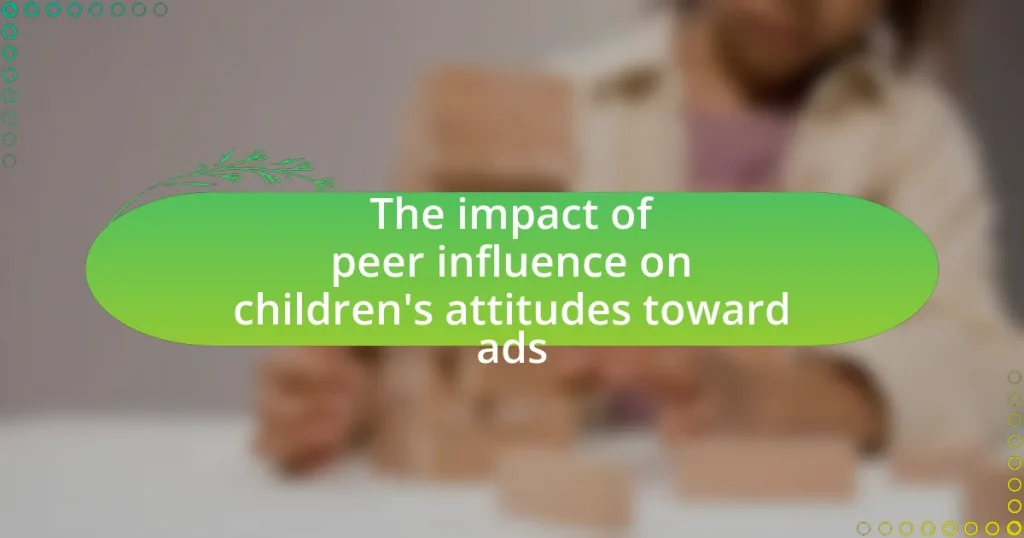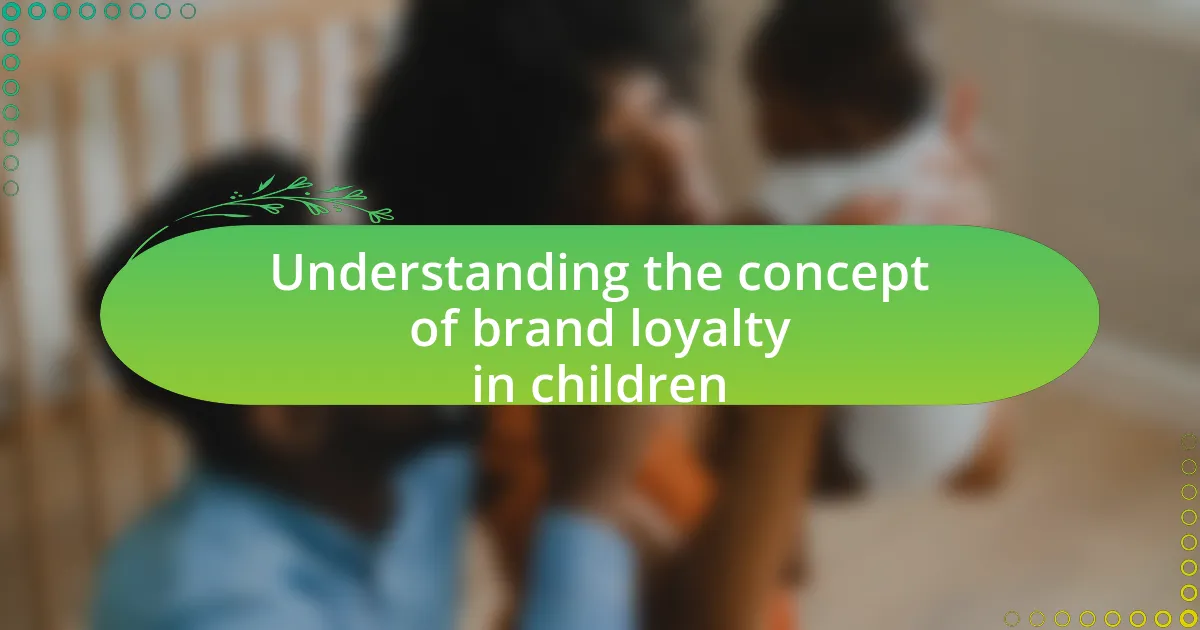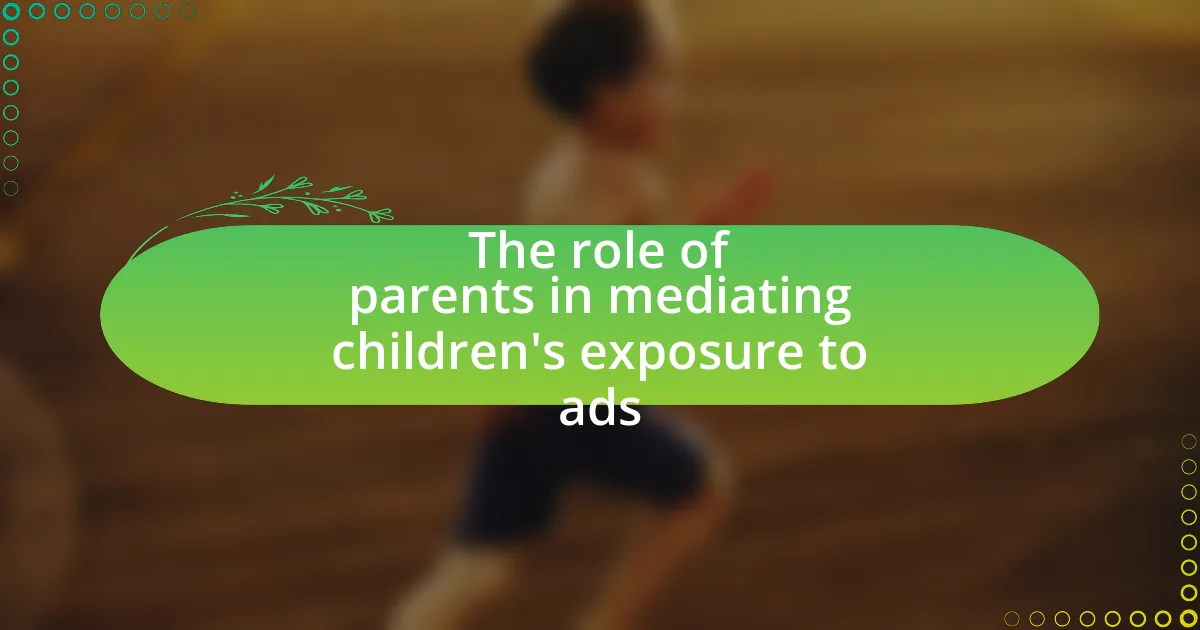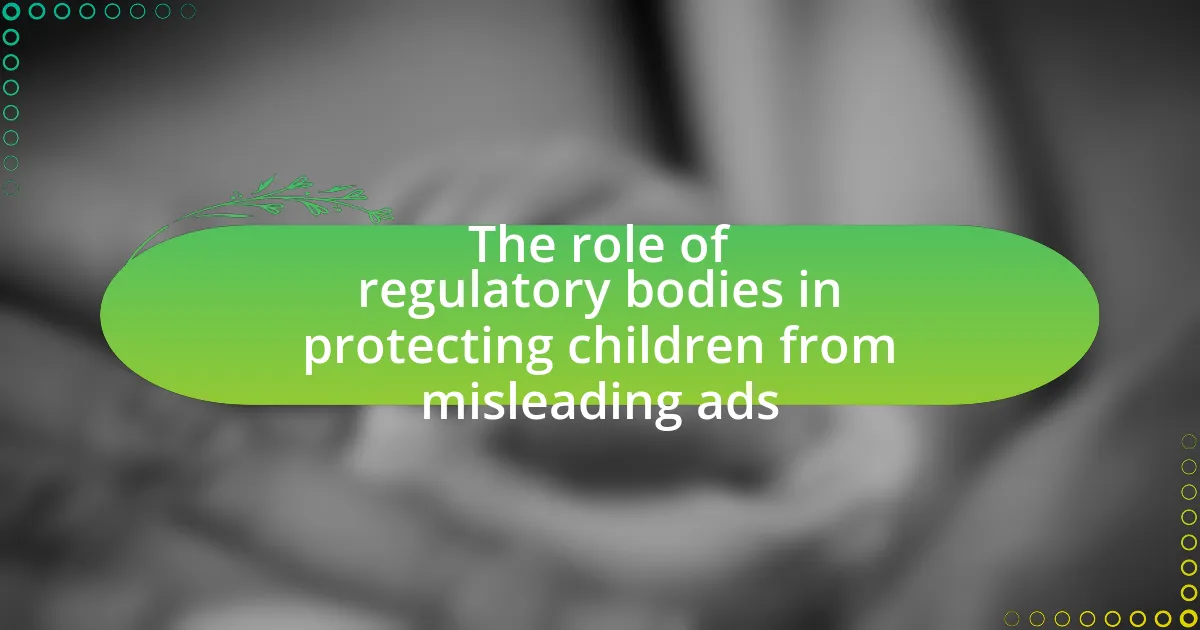The article examines the significant impact of peer influence on children’s attitudes toward advertisements, highlighting how social dynamics shape their perceptions and behaviors. Research indicates that children, particularly those aged 8 to 12, are more likely to trust and engage with ads endorsed by their peers, leading to increased brand loyalty and purchasing behavior. The article discusses the role of peer discussions, social validation, and cognitive development in shaping children’s responses to advertising, as well as strategies for marketers to effectively leverage peer influence. Additionally, it emphasizes the importance of media literacy and critical thinking skills for parents and educators to help children navigate peer pressure related to advertisements.
What is the impact of peer influence on children’s attitudes toward ads?
Peer influence significantly shapes children’s attitudes toward advertisements. Research indicates that children are more likely to accept and engage with ads when their peers express positive opinions about them. A study published in the Journal of Advertising Research found that children aged 8 to 12 are particularly susceptible to peer approval, leading them to favor products endorsed by friends or seen as popular within their social circles. This peer validation can enhance the perceived credibility of advertisements, making children more receptive to marketing messages.
How does peer influence shape children’s perceptions of advertisements?
Peer influence significantly shapes children’s perceptions of advertisements by altering their attitudes and beliefs based on the opinions and behaviors of their friends. Research indicates that children are more likely to trust and engage with advertisements that are endorsed or discussed positively by their peers, as they seek social validation and acceptance. A study published in the Journal of Advertising Research found that children aged 8 to 12 are particularly susceptible to peer influence, with 70% reporting that their friends’ opinions affect their preferences for products. This demonstrates that peer dynamics play a crucial role in how children interpret and respond to advertising messages, often leading them to align their preferences with those of their social group.
What role do friends play in shaping attitudes toward specific ads?
Friends significantly influence attitudes toward specific ads by providing social validation and shaping perceptions through discussions and shared experiences. Research indicates that children are more likely to adopt positive attitudes toward advertisements endorsed by their peers, as they seek acceptance and approval within their social circles. A study published in the Journal of Advertising Research found that peer recommendations can enhance the effectiveness of ads, particularly among younger audiences, demonstrating that social interactions play a crucial role in how children interpret and respond to advertising messages.
How do peer discussions affect children’s trust in advertisements?
Peer discussions significantly influence children’s trust in advertisements by shaping their perceptions and beliefs about the credibility of the messages. When children engage in conversations with peers about advertisements, they often share opinions and experiences that can either reinforce or challenge the trustworthiness of the ads. Research indicates that children are more likely to trust advertisements that align with the views expressed by their peers, as social validation plays a crucial role in their decision-making processes. For instance, a study published in the Journal of Advertising Research found that children who discussed ads with friends were more likely to adopt their peers’ attitudes, leading to increased trust in those advertisements. This demonstrates that peer influence is a powerful factor in determining how children interpret and respond to advertising content.
Why is understanding peer influence important for marketers?
Understanding peer influence is crucial for marketers because it significantly shapes children’s attitudes toward advertisements and brand perceptions. Research indicates that children are highly susceptible to peer opinions, with studies showing that peer recommendations can increase the likelihood of product adoption by up to 50%. This influence can lead to increased brand loyalty and purchasing behavior, as children often seek validation from their peers when making choices. Therefore, marketers who leverage peer influence can create more effective advertising strategies that resonate with young audiences, ultimately driving sales and brand engagement.
What insights can marketers gain from studying peer influence?
Marketers can gain valuable insights into consumer behavior by studying peer influence, particularly in how it shapes children’s attitudes toward advertisements. Understanding that children are significantly affected by their peers allows marketers to tailor their strategies to leverage social dynamics, enhancing the effectiveness of their campaigns. Research indicates that children are more likely to adopt preferences and behaviors endorsed by their friends, which suggests that peer recommendations can amplify brand loyalty and purchase intentions. For instance, a study published in the Journal of Advertising Research found that children exposed to peer-endorsed products showed a 30% increase in positive attitudes toward those products compared to those who were not. This highlights the importance of integrating peer influence into marketing strategies aimed at younger audiences.
How can marketers tailor ads to resonate with peer-influenced children?
Marketers can tailor ads to resonate with peer-influenced children by incorporating relatable peer dynamics and social validation into their messaging. Research indicates that children are significantly influenced by their peers, often valuing the opinions and behaviors of friends over adults. For instance, a study published in the Journal of Consumer Research found that children are more likely to engage with brands that their peers endorse or that feature relatable characters in social settings. By using familiar social scenarios, showcasing peer interactions, and emphasizing group approval, marketers can create ads that align with children’s social experiences, thereby enhancing the effectiveness of their campaigns.
What factors contribute to peer influence on children’s attitudes toward ads?
Peer influence on children’s attitudes toward ads is primarily shaped by social dynamics, including conformity, social validation, and shared experiences. Children often seek acceptance from their peers, leading them to adopt similar attitudes toward advertisements that their friends endorse. Research indicates that children are more likely to express positive attitudes toward ads when they perceive that their peers appreciate those ads, as seen in studies where peer discussions significantly altered children’s perceptions of advertised products. Additionally, the presence of peer approval can enhance the credibility of the advertisement, making children more receptive to its messages.
How do age and developmental stages affect peer influence?
Age and developmental stages significantly affect peer influence by shaping children’s social interactions and susceptibility to peer opinions. Younger children, typically in early childhood, are more likely to conform to peer influence due to their developing social skills and desire for acceptance, as evidenced by studies showing that children aged 4 to 7 are highly influenced by their peers in decision-making processes. As children enter middle childhood, around ages 8 to 12, they begin to develop a stronger sense of individuality and critical thinking, which can reduce the impact of peer influence, although they still seek peer approval. Adolescents, aged 13 to 18, experience heightened peer influence as they navigate identity formation and social hierarchies, often prioritizing peer opinions over parental guidance, supported by research indicating that adolescents are more likely to engage in risk-taking behaviors when in the presence of peers. Thus, the interplay between age and developmental stages creates varying levels of susceptibility to peer influence throughout childhood and adolescence.
What differences exist in peer influence between younger and older children?
Younger children are more susceptible to peer influence than older children, primarily due to their developmental stage and socialization processes. Research indicates that younger children, typically aged 5 to 7, often rely on peers for social validation and acceptance, leading them to conform to group norms more readily. In contrast, older children, particularly those aged 11 to 14, develop a stronger sense of individuality and critical thinking skills, which enables them to resist peer pressure more effectively. A study published in the Journal of Youth and Adolescence found that older adolescents are more likely to evaluate peer influence critically, whereas younger children may accept peer opinions without question. This difference in susceptibility to peer influence significantly impacts how children respond to advertisements, with younger children being more likely to adopt attitudes and behaviors promoted by their peers.
How does cognitive development impact children’s responses to peer influence?
Cognitive development significantly influences children’s responses to peer influence by shaping their ability to understand social dynamics and evaluate peer behaviors critically. As children progress through cognitive developmental stages, particularly during middle childhood and adolescence, they develop enhanced reasoning skills, which enable them to assess the motivations behind peer actions and the consequences of conformity. Research indicates that children with advanced cognitive abilities are more likely to resist negative peer pressure and make independent choices, as they can foresee potential outcomes and weigh options more effectively. For instance, studies show that adolescents with higher cognitive maturity are better at recognizing when peer influence may lead to unhealthy behaviors, allowing them to navigate social situations with greater autonomy.
What social dynamics play a role in peer influence?
Social dynamics that play a role in peer influence include conformity, social norms, and group identity. Conformity occurs when individuals adjust their behaviors or beliefs to align with those of their peers, often driven by the desire for acceptance or fear of rejection. Social norms establish the unwritten rules of behavior within a group, influencing how children perceive and respond to advertisements based on what is deemed acceptable or popular among their peers. Group identity fosters a sense of belonging, leading children to adopt attitudes and behaviors that reflect the values of their peer group, which can significantly shape their responses to marketing messages. Research indicates that children are particularly susceptible to peer influence, as demonstrated in studies showing that peer opinions can alter children’s preferences for products and brands, thereby impacting their attitudes toward advertisements.
How do group norms affect children’s attitudes toward ads?
Group norms significantly shape children’s attitudes toward advertisements by influencing their perceptions of what is acceptable or desirable. When children observe their peers responding positively to certain ads, they are more likely to adopt similar attitudes, as they seek social acceptance and validation. Research indicates that children are particularly susceptible to peer influence, with studies showing that those who perceive their friends as enjoying specific brands or products are more inclined to express favorable attitudes toward those advertisements. For instance, a study published in the Journal of Advertising Research found that children who identified with a peer group that favored a particular brand were more likely to develop a positive attitude toward ads promoting that brand, demonstrating the powerful role of group norms in shaping consumer behavior.
What is the impact of social media on peer influence regarding advertisements?
Social media significantly amplifies peer influence on advertisements, particularly among children and adolescents. Research indicates that exposure to peers’ opinions and behaviors on social media platforms can shape young people’s attitudes toward brands and products. For instance, a study published in the Journal of Advertising Research found that 70% of teenagers are influenced by their peers’ social media posts when making purchasing decisions. This influence is further enhanced by the interactive nature of social media, where likes, shares, and comments create a sense of validation and desirability around advertised products. Consequently, social media serves as a powerful tool for advertisers to leverage peer dynamics, ultimately affecting children’s perceptions and attitudes toward ads.
How can parents and educators mitigate negative peer influence on children’s attitudes toward ads?
Parents and educators can mitigate negative peer influence on children’s attitudes toward ads by fostering critical thinking and media literacy skills. Teaching children to analyze and question advertisements helps them recognize persuasive techniques and develop a more discerning view of marketing messages. Research indicates that children who receive media literacy education are better equipped to resist peer pressure related to advertising, as they can identify manipulative tactics used in ads (Levine, 2018, Journal of Advertising Research). Additionally, creating open discussions about advertising in family and classroom settings encourages children to express their thoughts and feelings, reinforcing their ability to resist negative influences from peers.
What strategies can parents use to guide children’s understanding of ads?
Parents can use several strategies to guide children’s understanding of ads, including discussing the purpose of advertising, encouraging critical thinking, and promoting media literacy. By explaining that ads are designed to persuade consumers to buy products, parents help children recognize the intent behind advertisements. Encouraging critical thinking involves asking children questions about the ads they see, such as what message is being conveyed and whether the claims are believable. Promoting media literacy can be achieved through activities like analyzing different types of ads and discussing their techniques, which helps children understand how ads can influence their perceptions and choices. Research indicates that children who engage in discussions about advertising are better equipped to critically evaluate ads, leading to more informed consumer behavior.
How can open discussions about advertising help children critically evaluate ads?
Open discussions about advertising can help children critically evaluate ads by fostering analytical thinking and encouraging skepticism towards marketing messages. Engaging children in conversations about the intent behind advertisements allows them to recognize persuasive techniques, such as emotional appeals and misleading claims. Research indicates that when children participate in discussions about advertising, they develop a better understanding of the difference between entertainment and marketing, which enhances their ability to discern the credibility of ads. For instance, a study published in the Journal of Advertising Research found that children who were taught to analyze advertisements showed improved critical thinking skills and were less likely to be influenced by deceptive advertising tactics.
What role does media literacy education play in shaping children’s attitudes?
Media literacy education plays a crucial role in shaping children’s attitudes by equipping them with critical thinking skills necessary to analyze and evaluate media messages. This education fosters an understanding of advertising techniques and the persuasive intent behind them, enabling children to discern between entertainment and manipulation. Research indicates that children who receive media literacy education are more likely to develop skepticism towards advertisements, leading to healthier consumption habits and reduced susceptibility to peer influence. For instance, a study published in the Journal of Advertising Research found that media literacy programs significantly improved children’s ability to identify advertising strategies, thereby influencing their attitudes towards ads positively.
What best practices can educators implement to address peer influence?
Educators can implement collaborative learning strategies to address peer influence effectively. By fostering group work and peer discussions, educators create an environment where students can share diverse perspectives and critically evaluate peer opinions. Research indicates that collaborative learning enhances critical thinking and reduces negative peer pressure, as students learn to articulate their views and consider alternative viewpoints (Johnson & Johnson, 2009). Additionally, incorporating social-emotional learning (SEL) programs helps students develop self-awareness and interpersonal skills, enabling them to navigate peer influence more effectively. Studies show that SEL programs lead to improved decision-making and resilience against negative peer pressure (Durlak et al., 2011).
How can classroom activities promote critical thinking about advertisements?
Classroom activities can promote critical thinking about advertisements by engaging students in analysis and discussion of ad content, techniques, and messages. For instance, activities such as dissecting advertisements for persuasive strategies, evaluating the credibility of claims, and comparing different ads for the same product can enhance students’ ability to critically assess advertising. Research indicates that when students participate in collaborative discussions about media, they develop stronger analytical skills and a deeper understanding of persuasive techniques, which can lead to more informed consumer behavior.
What resources are available for teaching children about advertising ethics?
Resources available for teaching children about advertising ethics include educational programs, books, and online platforms. For instance, the “Media Literacy Now” initiative provides comprehensive resources aimed at enhancing media literacy, which encompasses understanding advertising ethics. Additionally, books such as “The Advertising Effect: How to Change Behaviour” by Adam Ferrier offer insights into the ethical implications of advertising. Online platforms like Common Sense Media provide lesson plans and activities focused on advertising ethics, helping children critically analyze advertisements and understand their persuasive techniques. These resources collectively support educators in fostering ethical awareness regarding advertising among children.
What practical tips can help children navigate peer influence regarding ads?
Children can navigate peer influence regarding ads by developing critical thinking skills and practicing media literacy. Encouraging children to question the motives behind advertisements helps them understand that ads are designed to persuade, not inform. For instance, discussing how ads often use emotional appeals or celebrity endorsements can make children more aware of manipulation tactics. Additionally, engaging in conversations about the difference between needs and wants can empower children to make informed choices rather than succumbing to peer pressure. Research indicates that children who are taught to analyze advertisements are less likely to be influenced by peers, as they can recognize persuasive techniques and assess the value of products independently.






